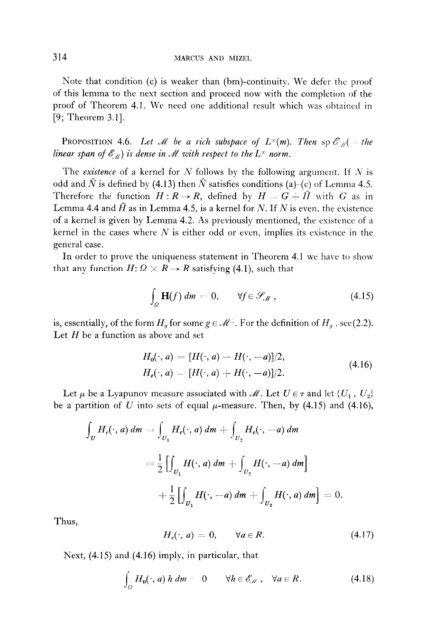Extension Theorems of Hahn-Banach Type for Nonlinear Disjointly ...
Extension Theorems of Hahn-Banach Type for Nonlinear Disjointly ...
Extension Theorems of Hahn-Banach Type for Nonlinear Disjointly ...
You also want an ePaper? Increase the reach of your titles
YUMPU automatically turns print PDFs into web optimized ePapers that Google loves.
314 MARCUS AND MIZEL<br />
Note that condition (c) is weaker than (bm)-continuity. We defer the pro<strong>of</strong><br />
<strong>of</strong> this lemma to the next section and proceed now with the completion <strong>of</strong> the<br />
pro<strong>of</strong> <strong>of</strong> Theorem 4.1. We need one additional result which was obtained in<br />
[9; Theorem 3.11.<br />
PROPOSITION 4.6. Let & be a rich subspace <strong>of</strong> Ll(m). T’hez sp C,,( the<br />
linear span <strong>of</strong> rZfl) is dense in A![ with respect to the Lr norm.<br />
The existence <strong>of</strong> a kernel <strong>for</strong> N follows by the following argument. If ;V is<br />
odd and fi is defined by (4.13) then l%r satisfies conditions (a))(c) <strong>of</strong> Lemma 4.5.<br />
There<strong>for</strong>e the function H : R + R, defined by H G 2 I^r with G as in<br />
Lemma 4.4 and l? as in Lemma 4.5, is a kernel <strong>for</strong> N. If N is even, the existence<br />
<strong>of</strong> a kernel is given by Lemma 4.2. As previously mentioned, the existence <strong>of</strong> a<br />
kernel in the cases where X is either odd or even, implies its existence in the<br />
general case.<br />
In order to prove the uniqueness statement in Theorem 4.1 we have to show<br />
that any function H: Sz x R + R satisfying (4.1) such that<br />
i’ H(f) dm 0, Vf E ?I > (4.15)<br />
R<br />
is, essentially, <strong>of</strong> the <strong>for</strong>m H, <strong>for</strong> someg E A-. For the definition <strong>of</strong> H, . ~~(2.2).<br />
Let H be a function as above and set<br />
H,,(., a> = [H(., a) - H(., -a)]i2,<br />
H,(., a) ~~ [H(., a) -I- H(., -a)]/2.<br />
(4.16)<br />
Let p be a Lyapunov measure associated with AC. Let U E 7 and let {Ur , U,jbe<br />
a partition <strong>of</strong> U into sets <strong>of</strong> equal p-measure. Then,<br />
s<br />
by (4.15) and (4.16),<br />
H,(., a) dm : Jb, Hk, 4 dm -t ju. Hk, -a)<br />
u 2<br />
elm<br />
Thus,<br />
1<br />
z = 2 [I, fJ(., 4 dm + Ju,, HC.9 -4 dm]<br />
1<br />
+ i [jul H(*, -a) dm -i- ju2 H(., a) dm] == 0.<br />
Zi,(., a) Mom 0, Va E R.<br />
Next, (4.15) and (4.16) imply, in particular, that<br />
jD H,(., a) h dm 0 Vh E CT,, , Vu E R.<br />
(4.17)<br />
(4.18)

















